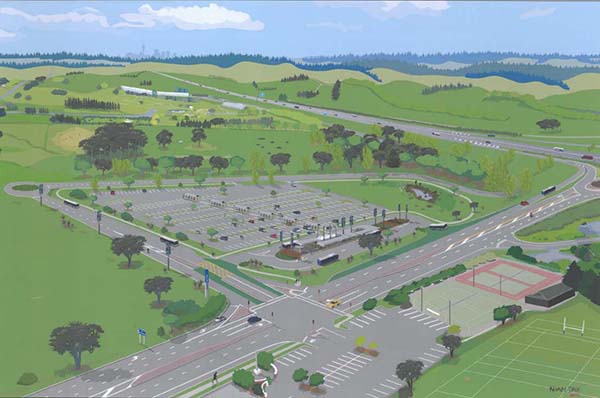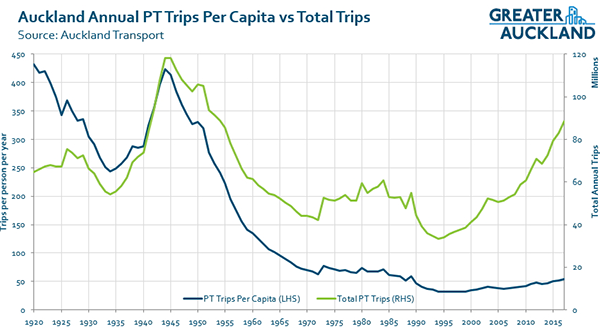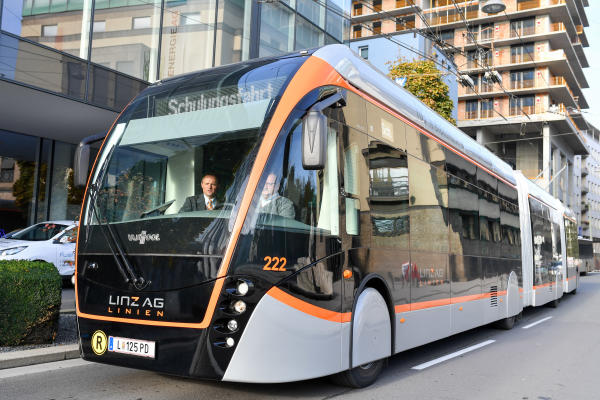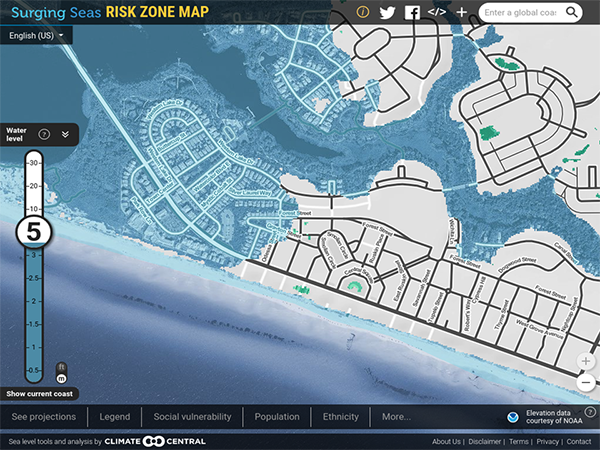Triggering automatic change to green

Buses Need to Trigger Change: As attractive as this rendering of the Hibiscus Coast busway may be, the Warkworth satellite growth centre needs to be designed several generations further ahead in its thinking than park-and-ride, with ride-and-ride, walk-and-ride and bike-and-ride, and for the station itself to not resemble the social deserts that are the others along the busway—devoid of civilised places for people to meet or work. Mahurangi’s essentially new tidehead town needs all the help it can get with this, including from the University of Auckland’s Transportation Research Centre. Meanwhile, until such time buses have priority lanes in and out of stations such as the one depicted, they need to automatically trigger traffic lights to green, as they, in this case, enter the station. rendering Auckland Transport
Most Warkworthians are unhappy that their town is now a satellite growth centre.
Had a concerted campaign been waged against it, and unlimited funds spent fighting it, Auckland Council may have been forced to rethink.
But that would not have stopped the Mahurangi population growing, and, arguably, planned-for growth could potentially produce a vastly more palatable outcome. And while most insiders will consider the notion naive, a case can be made for dreaming big, and visualising a beautiful, fit-for-service and affordable tidehead town.
Two immense barriers stand between the dream of a beautiful, fit-for-service town and its realisation. The first has long existed. Although entire exemplary towns have been planned and built, worldwide they are tellingly few in number. Towns, mostly, are designed and built by landowner–developers, either adhering to, or strenuously resisting, local authority zoning laws. Any prospect of urban-design cohesion across a new town ranges from minimal to non-existent. The second barrier is an almost total lack of consensus as to what the criteria for a fit-for-service town in the first half of the 21st century might look like.
If there is a consensus, it is probably of something solar-panelled and electric-vehicled. Public transport remains, for most, an anathema. Yet Aucklanders once clambered onto electric trams in droves. After three generations of determinedly car-centric lifestyles, any transport solution is taken seriously as long as it doesn’t threaten the primacy of the automobile, emphasis on auto = self. Ironically, the public transport that carries no stigma is flying, where individuals are subjected to far greater indignities than the average metropolitan bus user, but which is generously offset by the status it endows.

Public Transport Has Long Way to Go: While the Northern Busway is an unbridled success, public transport in the region has a very long way to go from its 12-fold slump from when the efficiency of electrically-driven steel tram wheels ruled Auckland okay. chart Greater Auckland
The Labour Party’s transport minister Phil Twyford tweeted:
What if Government policy said to councils please maximise shift from single-occupant cars to public transport/walking and cycling—you reduce PT fares and increase services to drive the shift and we’ll support by increasing subsidies.
And subsequently said to the New Zealand Herald:
One of the best ways to reduce congestion is encouraging people to leave the car at home and take public transport.
But even if public transport was free, cars will still clog the streets to a standstill, unless the buses are given priority everywhere, and this urgently needs to go far beyond bus-lane thinking—the region’s buses, to cope with greater patronage, need to be given priority of movement on the region’s roads, but particularly at the region’s intersections. Nothing will shift people from cars to buses faster than the realisation that the buses provide the priority service. This is not idle speculation, nor public transit theory, it is what happened almost immediately the Northern Busway opened for business, when dead-in-the-water car drivers, were forced to watch while their more-savvy compatriots swept serenely by, to reach the central business district an hour ahead of them. Although the busway now carries 5 million passengers per year, per capita public transport patronage in the region is only an eighth of what it was in the heyday of the trams.

Smarter Use of Batteries: While this double-articulated bus may appear long at 24 metres, the 180 people it carries, if driving an electric car each at 50 kilometres per hour at the minimum legal following distance, would need 4.4 kilometres* of roadway. The batteries it carries enables it to run free of the catenary, providing flexibility once only dreamed of, and making it ideal for navigating busway stations. *based on 4490-millimetre length of Nissan Leaf (ZE1) | image Linz AG
Europe has Europe has numerous examples of transit-priority implementations, including in Athens, Dublin, Munich, Turin, Vienna, and Zurich. Some have highly sophisticated bus-prioritising traffic light systems; others are cravenly apologetic in approach, and only risk the wrath of the car-lobby by prioritising buses that are running ‘behind schedule’—the schedule dictated by car-clogged streets. But this is where the dots are not being connected. Public transport is no longer just about providing for the car-challenged, nor just about traffic congestion or dangerous urban air pollution. Public transport is now about the desperate, last-ditch battle to preserve a survivable climate. But without widespread appreciation of just how profound a change is needed to give the low-lying masses even a fighting chance, there will be scant political support for the radical action future historians will struggle to explain the absence of.
While not diminishing the role of rail, or its potential role, the stupendous investment to date in the region’s roading infrastructure, the impossible-to-overstate urgency is to get cars off it, and prioritise its use for electrified public transport, and for service vehicles. Left to the market place, the roads are otherwise doomed to be more choked by electric cars than they currently are by fossil-fuelled ones. Batteries are needed bigtime, but to power buses through gaps in the catenary. Electric trains are not expected to run without grid power, supplied directly, but Wellington is testimony to the small-government mentality that saw no one prepared to invest in green infrastructure, yet places complete faith in ‘innovation’ and its even trendier sibling ‘disruption’ to somehow ensure that global greenhouse gas emissions go to zero. Where greenhouse gas emissions are falling, it is because they are being exported, and, globally, not only are emissions forecast to continue to rise, along with economic activity, the warming effect is essentially forever.

Did Like to Be Beside the Seaside: Seaside, on Florida’s panhandle, might be a model town—though tending more than a little towards the chocolate box—but even by 1980, when it was being built, the National Academy of Sciences had warned, three years earlier, that average temperatures could rise 6° by 2050, due to the burning of coal. Warkworth might be miles from the sea, but is only metres above sea level, and the irrevocable melting of the ice sheets will, in the fullness of time, submerge the entire satellite town, destined to become the seabed of the Kaipara–Mahurangi Straits. map Climate Central
In Aotearoa, road-vehicle emissions rose 80% from 1990 to 2015, making up 37% of all carbon dioxide emitted—any clean–greenness the country can claim is entirely attributable to its geography, and not to its citizens’ lifestyles. But again, with appreciation of the big picture at a forlornly low level, factoring fit-for-purpose transportation into the design of the new Warkworth will be hugely challenging. Environmental psychologists would counsel against warning of the dire consequences of burgeoning population and climate-challenged ability to grow food, or of sea-level-rise induced mass migration. Instead, the selfish concerns of individuals, supposedly, must be appealed to, such as walkable towns being healthier towns, with more space for greenspace.
The abject recklessness of the softly-softly approach is that the planetary experiment currently being conducted is without precedent. Carbon dioxide levels are increasing 100 times faster that they did at the end of the last glaciation, and it will only be with the benefit of hindsight it will be known whether, by 2018, a survivable climate could have been preserved. The benefit of the doubt must be given to taking urgent action, and no more so when designing almost an entirely new town, when, above all else, it must be fit-for-service, and beautiful for it.
And, like buses approaching an intersection, automatically trigger a change to green.

Cimino, thanks so much for the post. Much thanks again. Really Cool.